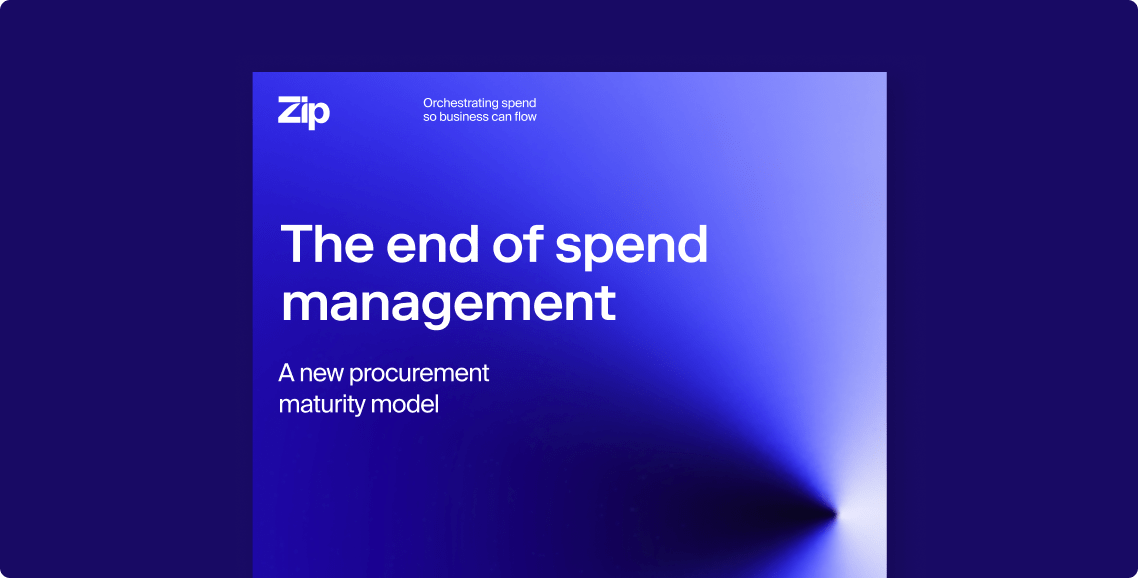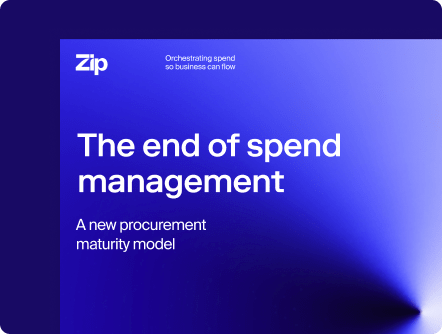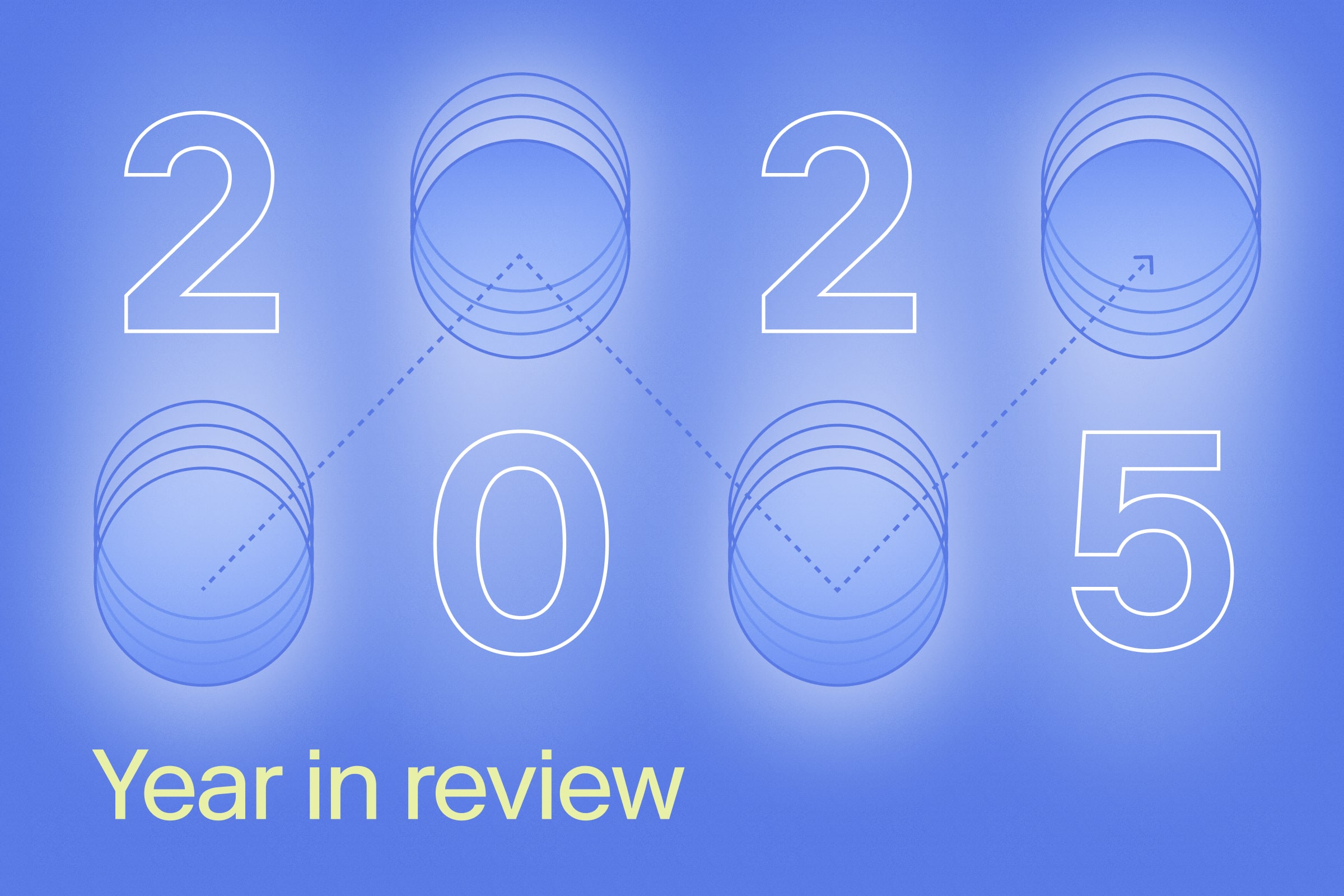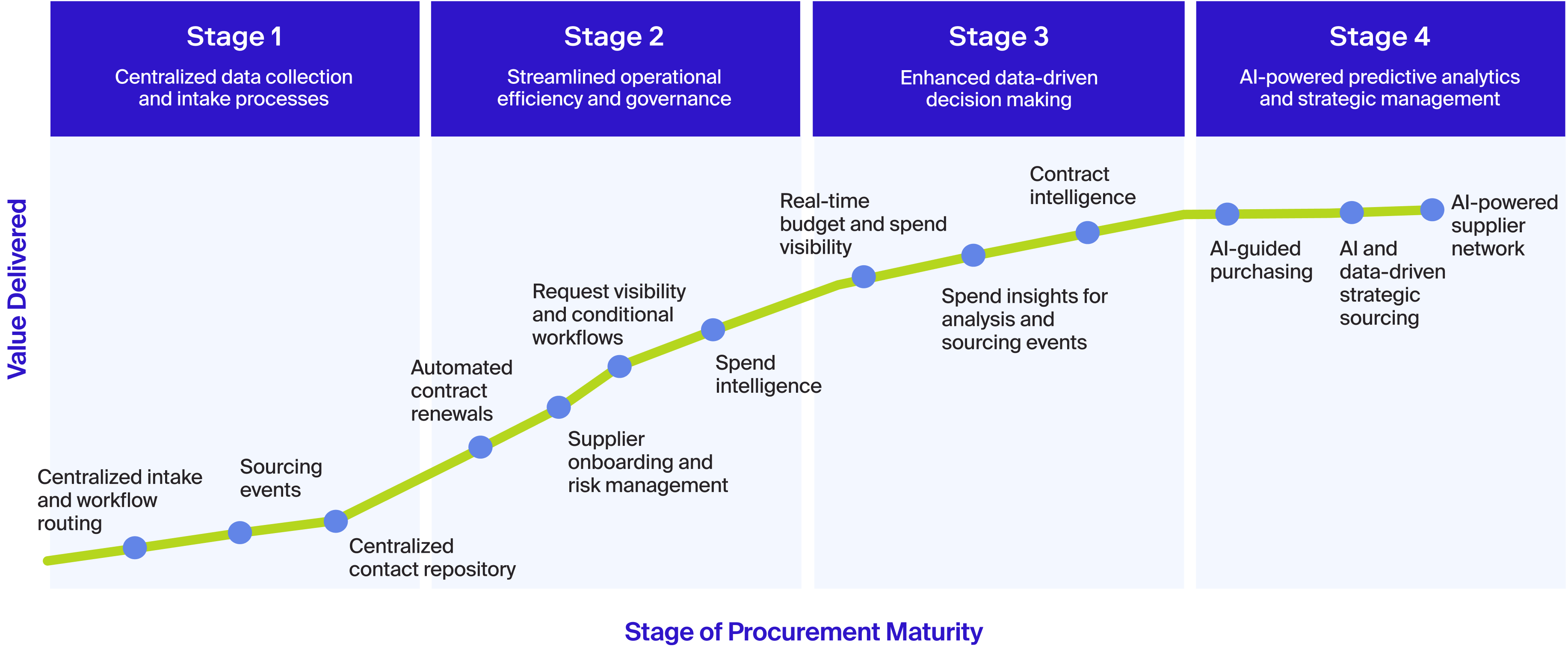
The end of spend management: A new model for procurement
How to assess procurement maturity and unlock the power of spend orchestration.

Procurement is no longer centralized or limited to a few decision-makers.
Today, it’s a distributed function: more stakeholders, more systems, and more complexity. Teams face growing volumes of purchasing requests, all while ensuring spend supports strategic goals like cost savings, ESG, and sustainability.
Traditional spend management can’t keep up.
Built for transactional buying, legacy systems weren’t designed for today’s strategic demands. What’s needed now is a new model, one that empowers employees across the business, while aligning every dollar to top-down objectives.
of procurement executives acknowledge that they do not have the right resources in place today, according to The Hackett Group.
Download this guide as an ebook

The New Procurement Intake and Orchestration Maturity Model helps organizations assess their current state and chart a path toward a more efficient, modern approach.
At its core is spend orchestration, a flexible, scalable alternative to rigid legacy systems, powered by advancements in AI.
This guide will help you identify your maturity stage, uncover the value of orchestration at every level, and build a future-ready procurement strategy that drives lasting business impact.
The end of spend management
The end of spend managementProcurement teams today face rising complexity and pressure to align every dollar with strategic goals, yet legacy systems can’t keep up with how businesses now operate and scale.
According to The Hackett Group, procurement workloads rose 8.0% in 2024, without meaningful increases in headcount or budget, widening productivity and efficiency gaps by over 6%.
Traditional spend management suites were built for centralized procurement. But in today’s distributed model, where employees across the business are embedded in the purchasing process, these systems fall short.
The rigidity of legacy systems makes it difficult to adapt to the way we work today, involving multiple layers of approvals and compliance checks.
There are three fundamental issues with legacy spend management systems:
Breadth, not depth: They try to cover every procurement process but lack excellence in any one area, leading to poor tooling and vendor lock-in.
Not user-friendly: Designed for specialists, these tools are confusing or inaccessible for most employees.
Poor adoption: Difficult interfaces and limited visibility create bottlenecks and rogue spend. While 83% of CPOs now prioritize digitization, usage still lags.
Outdated P2P systems reduce productivity and limit procurement’s strategic potential. It’s time to replace them with flexible, intuitive, and AI-powered spend orchestration, built for how modern businesses work.
The solution is spend orchestration
Spend orchestration is the next evolution of digital transformation in procurement, enabling teams to operate in parallel across systems, stakeholders, and workflows.
Unlike legacy platforms, orchestration prioritizes flexibility and usability, breaking down silos and unlocking a more connected, efficient approach.
How spend orchestration differs from traditional suites:
Best-of-breed flexibility: Use the tools that work best for your business, without being locked into one vendor. Orchestration integrates across systems, enabling more effective procurement at every step.
Cost efficiency: No-code workflows let teams adapt quickly without relying on IT. The Hackett Group reports tech investments in procurement grew by 4.6% in 2024 to address efficiency gaps.
User-centered design: Built for everyone, not just specialists. Intuitive interfaces drive adoption and reduce rogue spend across the business.
Gartner® recently recognized procurement orchestration with a ‘transformational’ benefit rating, one that enables new ways of doing business and reshapes industry dynamics.As procurement becomes more distributed, orchestration offers the model to meet that complexity with simplicity and scale.
The six components of spend orchestration
Unified requests at intake
Provides a centralized platform for all purchase requests, streamlining the procurement process from the point of initial request.
Real-time collaboration
Enables key stakeholders to work together in parallel and in real-time, reducing blockers and bottlenecks.
Integrations
Flexible integrations ensure procurement and stakeholders can work across various best-of-breed platforms and systems.
No-code workflows
Allows non-technical employees to customize workflows, making the system adaptable and scalable for any finance or procurement requirement.
Central visibility
Offers a ‘single source of truth’ for procurement activities, ensuring transparency across teams.
AI guidance
AI-powered recommendations help optimize procurement decisions, reducing manual effort and improving outcomes.
Introducing a new procurement maturity model

As procurement becomes more strategic, businesses need a clear roadmap to assess their current capabilities and advance toward smarter, more efficient operations.
The Procurement Intake and Orchestration Maturity Model is a four-stage framework guiding companies from basic intake processes to fully integrated, AI-powered procurement, driving speed, compliance, and cost control across every request.
Before entering into the model, some organizations are still at Stage 0, with no formal intake process. Requests are fragmented, visibility is low, and there's little automation or compliance. Even a basic intake form without workflows can create friction and risk.
Moving beyond Stage 0 with centralized intake lays the foundation for control, visibility, and alignment with business goals.
Stage 1 introduces a centralized intake system where users can search vendors, review contracts, and submit purchase requests. Cross-functional teams (e.g. procurement, legal, IT) collaborate through shared tools to reduce silos and speed up decisions.
The value: visibility and streamlined collaboration. A centralized “single front door” improves compliance, vendor tracking, and record keeping.
Most orchestration adopters, like Zip customers, begin at Stage 2, focused on improving operational efficiency and compliance.
Here, workflow automation and conditional logic streamline approvals across Finance, Legal, IT, and Risk. Built-in compliance tools automate document collection, validate suppliers, and manage renewals.
This stage is critical for enterprises navigating complex regulations and third-party risk. Real-time spend intelligence and embedded risk controls ensure requests stay aligned with policies and global standards.
Companies ready to go further turn to Stages 3 and 4 for advanced data integration and AI-driven insights.
At Stage 3, organizations embed real-time budget and spend data into every approval. Approvers see current spend levels before approving requests, helping control costs and guide strategic investment.
Advanced contract intelligence and Total Cost of Ownership (TCO) analysis enable deeper insight into supplier value and long-term cost. Procurement becomes a fully data-informed function, aligned to business goals and optimized for strategic savings.a

Download this guide as an ebook
By filling out this form and clicking the submit button you are agreeing to receive email communications from Zip regarding events, webinars, research, and more. Don’t worry, you will be able to unsubscribe at any time. View our Privacy Notice. If you have any questions, please reach out to privacy@ziphq.com.
Stage 4 is the future: Agentic AI-guided procurement that transforms the function into a proactive, prediction-based, and autonomously-powered organization.
Predictive analytics surface spend risks, guide requesters, and benchmark supplier performance, all in real time. Agentic orchestration powers supplier networks with enhance decision-making with verified data, risk profiles, and contract terms, allowing autonomous agents the ability to enable deep supplier collaboration and innovation proactively.
This is agentic orchestration at its peak: a unified, intuitive platform where intake, supplier management, strategic sourcing, and agentic AI works together to maximize efficiency and impact.
Case study: Prudential Financial’s digital transformation
Prudential Financial, a Fortune 500 global financial services company operating in over 40 countries, faced complex procurement challenges across legal entities, regulatory frameworks, and distributed teams. To scale effectively, they needed greater efficiency, transparency, and automation.
Prudential’s journey demonstrates how a global financial leader began at a Stage 0 process, and is now looking toward the cutting edge of what’s possible in procurement.
At Zip Forward 2024, Prudential CPO Oliver Gall recalled the pain of outdated processes. Early in his career, managing a global contract required mailing it to 20 countries for signatures.
“We lost it somewhere between Japan and Australia. It took three months to finalize,” he said.
The inefficiencies made it clear: procurement at scale required a new approach.
Prudential began digitizing procurement with workflow automation—streamlining vendor onboarding, purchase orders, approvals, and payments.
“The new technology automated what we used to do manually,” said Gall. “It was faster, better, and cheaper. We needed fewer people to get more done.”
This shift marked Prudential’s transition from Stage 0 to a digitally enabled, scalable procurement model.
Now, Prudential is looking to the future: AI-powered procurement orchestration. With automation in place, the next goal is to leverage generative AI for even more efficiency and strategic value.
“Generative AI will write RFPs, analyze spend, and manage suppliers—better, faster, cheaper,” said Gall. “Zip gives us tens of thousands of hours back. We’re using those hours to build the next chapter of procurement.”
of procurement workflows will be automated, eliminated, or shifted to self-service, as a recent KPMG report noted.
Prudential’s transformation shows how orchestrated, AI-driven procurement can unlock time, reduce complexity, and elevate the function’s impact across the business.
The benefits of spend orchestration
Traditional, centralized procurement models can’t scale with modern business demands. Spend orchestration shifts control closer to the business, empowering teams to manage tasks while procurement takes on a more strategic role.
Automated, parallel workflows and real-time insights support scalable growth across distributed teams.
There’s an interesting phenomenon in transportation research where it was determined where new, or widened highways initially relieve congestion, but soon become just as congested or worse. This induced demand is because extra capacity—or increased supply—attracts more drivers (demand).
The solution is not to increase capacity for individuals, but offer alternative modes of operations.
This is akin to maturing procurement; orchestration offers smarter paths through automation and AI, which reduces bottlenecks by offering distributed processes and parallel workflows, not just wider lanes.
Orchestration enables employees to make smarter purchasing decisions through AI-guided workflows. Routine tasks are automated, so requesters can move faster, staying aligned with procurement goals without creating bottlenecks.
No longer locked into rigid suites, companies can adopt best-of-breed tools tailored to their needs. Spend orchestration connects these tools, improving efficiency, visibility, and outcomes across the procurement process.
Procurement becomes a strategic enabler, not a bottleneck. Orchestration ensures every dollar supports company priorities, from savings and compliance to ESG, all with less manual intervention.
Spend orchestration is the key to next-gen procurement maturity
Procurement has evolved from a back-office function to a strategic driver of value.
In today’s distributed and complex environments, modern procurement demands agility, scalability, and AI-powered insights to guide smarter decisions.
Spend orchestration enables this shift, unlocking efficiency, empowering employees, and transforming procurement from gatekeeper to facilitator.
The maturity model in this guide offers a clear roadmap to help organizations modernize step by step.
With Zip’s AI-powered platform, companies can streamline intake, automate workflows, and gain real-time visibility, driving greater impact at every stage.
By adopting orchestration, companies position procurement at the center of innovation, resilience, and long-term value creation.








.png)



